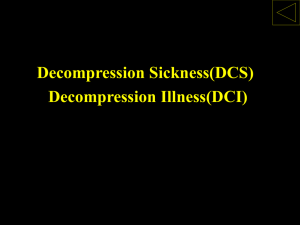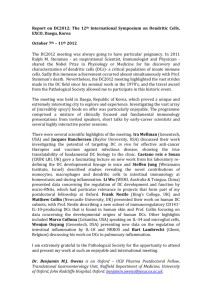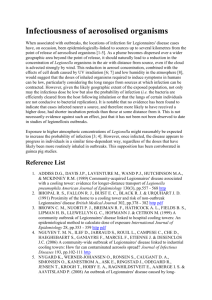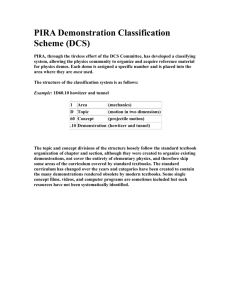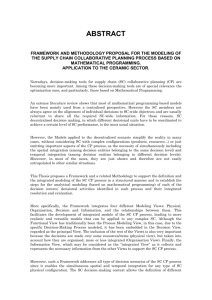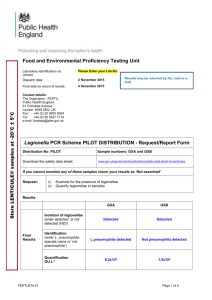29228 - جامعة الملك عبدالعزيز
advertisement
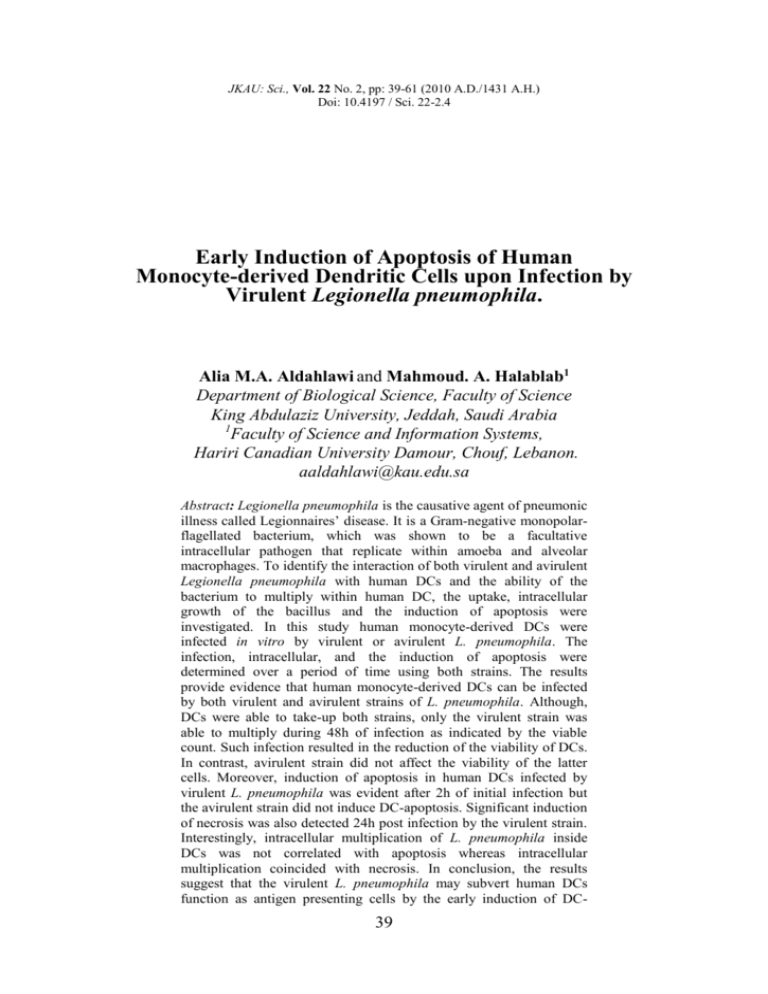
JKAU: Sci., Vol. 22 No. 2, pp: 39-61 (2010 A.D./1431 A.H.) Doi: 10.4197 / Sci. 22-2.4 Early Induction of Apoptosis of Human Monocyte-derived Dendritic Cells upon Infection by Virulent Legionella pneumophila. Alia M.A. Aldahlawi and Mahmoud. A. Halablab1 Department of Biological Science, Faculty of Science King Abdulaziz University, Jeddah, Saudi Arabia 1 Faculty of Science and Information Systems, Hariri Canadian University Damour, Chouf, Lebanon. aaldahlawi@kau.edu.sa Abstract: Legionella pneumophila is the causative agent of pneumonic illness called Legionnaires’ disease. It is a Gram-negative monopolarflagellated bacterium, which was shown to be a facultative intracellular pathogen that replicate within amoeba and alveolar macrophages. To identify the interaction of both virulent and avirulent Legionella pneumophila with human DCs and the ability of the bacterium to multiply within human DC, the uptake, intracellular growth of the bacillus and the induction of apoptosis were investigated. In this study human monocyte-derived DCs were infected in vitro by virulent or avirulent L. pneumophila. The infection, intracellular, and the induction of apoptosis were determined over a period of time using both strains. The results provide evidence that human monocyte-derived DCs can be infected by both virulent and avirulent strains of L. pneumophila. Although, DCs were able to take-up both strains, only the virulent strain was able to multiply during 48h of infection as indicated by the viable count. Such infection resulted in the reduction of the viability of DCs. In contrast, avirulent strain did not affect the viability of the latter cells. Moreover, induction of apoptosis in human DCs infected by virulent L. pneumophila was evident after 2h of initial infection but the avirulent strain did not induce DC-apoptosis. Significant induction of necrosis was also detected 24h post infection by the virulent strain. Interestingly, intracellular multiplication of L. pneumophila inside DCs was not correlated with apoptosis whereas intracellular multiplication coincided with necrosis. In conclusion, the results suggest that the virulent L. pneumophila may subvert human DCs function as antigen presenting cells by the early induction of DC- 39 Alia M.A. Aldahlawi and Mahmoud. A. Halablab 40 apoptosis that may contribute to the pathogenicity of the bacterium. Keywords: Legionella. pneumophila; Legoinnaires’disease; Virulent; A virulent; Maturation; Apoptosis Intruduction Legionella pneumophila, the causative agent of Legoinnaires’disease, is a facultative intracellular pathogen that can infect and/or multiply in different host cells including alveolar macrophages, human monocytes, and murine DCs[1-4]. Dendritic cells (DCs) are potent antigen presenting cells (APC) that are able to activate resting T cells to initiate primary immune response [5]. DCs are also a major source of IL-12 that is required for the sensitization of Th1 cells, which play a critical role in immune response against intracellular pathogens. Moreover, DCs are more potent antigen presenting cells than macrophages [6, 7]. DCs are highly responsive to inflammatory stimuli, such as bacterial LPS, which induce a series of phenotypic and functional changes in DCs. Interaction of Legoinnaires’disease bacterium with DCs have been investigated in marine systems[8,9] whereas the interaction with human DCs require further investigation. Many bacterial pathogens are known to induce apoptosis in host cells. Apoptosis of infected cells has recently been shown to play an important role in host-parasite relationships. For example, induction of macrophage apoptosis after bacterial infection could be a host mechanism to limit the bacterial replication[10], and reprocessing the killed bacteria for presentation by professional antigen presenting cells such as DCs[4,11,12]. However, the induction of DC-apoptosis in response to bacteria could be regarded as pathogenic, because DCs are responsible for the induction of cellular and humoral immune responses against these pathogens, thus apoptotic DCs may cause temporal disruption of the immunological barrier against infection[13]. Furthermore, apoptosis certainly down regulate DC function and their antigen presenting function in vivo[14]. Although, L. pneumophila has been described to induce apoptosis in many host cells including macrophages and monocytes[15], very little is known about the ability of Legionella to induce their apoptosis. For this reason, it was important to investigate whether L. pneumophila (virulent or avirulent) infection induces apoptotic or necrotic cell death in human DCs during intracellular infection. Recent study in murine model indicated that both DCs and macrophages have the ability to interfere with Legionella pneumophila replication through a cell death pathway mediated by caspas-1 and Naip-5[16]. Materials and Methods Legionella Strains The strain of Legionella pneumophila used in this study is L. pneumophila Philadelphia serogroup 1 (clinical strain), kindly provided by Dr. T. Harrison 41 Early Induction of Apoptosis of Human ……. (Central Public Health Laboratory, Colindale). L. pneumophila serogroup 1 (NCTC 11192) was used in this study as an avirulent strain determined by lethality to guinea pigs (LD50) by aerosol transmission[17,18]. The cells were grown in -BYE broth medium for 48h at 37C under constant agitation using an orbital incubator shaker, washed 3 times in HBSS buffer, and the concentration was adjusted to optical density 1 (4x108 cfu) using 1.5ml disposable cuvettes in a Gallenkamp Visispectrophotometer at 600 nm. Preparation of Human Peripheral Blood Monocytes The PBMCs were isolated from diluted blood using Lymphoprep (Robbins-Scientific) density gradient centrifugation by layering diluted blood on Lymphoprep. This was centrifuged at 1600 rpm using a MSE mistral 3000i centrifuge at room temperature for 30 min. The PBMCs band was removed and washed twice in HBSS at 1600 rpm at room temperature for 10 min. The resulting pellet was re-suspended in 30 ml Red blood cell lyses buffer (0.85% Ammonium chloride) for 5 min to lyse red blood cells then washed twice in cold HBSS and centrifuged at 1600 rpm at 4C for 10 min. After washing, the PBMCs were suspended in RPMI-1640 medium without antibiotics, counted then plated in 12-well plates (Costar) at a density of 5 x 106 cell ml–1. Plates were then incubated for 2h at 37C in a humidified incubator (5% CO2). Nonadherent cells were removed by washing the plates 3 times with warm RPMI-1640 medium. The remaining adherent monocytes were used in the experiments. Preparation of Dendritic Cells from Human Monocytes Dendritic cells were prepared from peripheral blood monocytes of healthy individuals using a method described by(19). Monocytes preparation was performed as described previously. Adherent monocytes were cultured in RPMI-1640 medium plus 10% foetal bovine serum (Gibco-BRL), and 1% Lglutamine at 37C under 5% CO2, in the presence of 800 U/ml of recombinant human GM-CSF (Pepro-Tech) and 500 U/ml of recombinant human IL-4 (Pepro-Tech). To induce maturation, human DCs were further cultured with LPS (Sigma) (1 μg ml-1) for 24h. Approximately, 2-6 x106 DCs were generated from 50-60 ml whole blood. Determination of Viability of DCs Samples of cell suspension were mixed with equal amount of 0.04% trypan blue (Sigma) and viable cells determined by trypan blue exclusion using a haemocytometer chamber. Cell viability was determined using light microscope and the results were expressed as the percentage of surviving cells. Alia M.A. Aldahlawi and Mahmoud. A. Halablab 42 DC Differentiation by Flow Cytometric Analysis DC differentiation was assayed by indirect immunofluorescence staining followed by flow cytometry analysis. The cells were stained in PBS by adding one of the following isothiocyanate (FITC)-conjugated monoclonal antibodies (MAbs): anti-CD14 (UCHM1, Serotec), anti-CD80 (BB-1, Insight), anti-CD83 (HB15, ImmunoKontact), anti-CD86 (BU63, Serotec), and anti-HLA-DR (TU36, BD-PharMingen, San Diego, Calif.). In control samples, the MAbs were replaced by matched isotype control mouse Ig (BD-PharMingen) and incubated on ice for 30 min. After staining and washing twice in cold PBS, the cells were fixed in 1% formalin fixative. Acquisitions were based on 10,000 events and data were analysed using CellQuest software (Becton Dickinson). Gating on DCs population was done to exclude dead cells and contaminating lymphocytes by forward and side scatter properties. The results are shown as the mean fluorescence intensity (MFI) or overlaid histograms. Cells cultivated for 6 days in RPMI-1640 supplemented with recombinant human GM-CSF and recombinant human IL-4 showed the immature phenotype and did not express CD83. Infection of Human DC with L. Pneumophila and the Determination of Viable Bacterial Count On day seven, nonadherent DCs were collected and counted prior to infection. Cells at a density of 5x105 cells ml-1per well were infected with virulent and avirulent L. pneumophila strains at a ratio of 10:1 bacteria to DC for 1h. Extracellular bacteria were removed by three times washing DCs in HBSS and treated with fresh RPMI-1640 medium containing 100μgml-1 gentamicin for 1h. DCs were rewashed and incubated in fresh antibiotic-free RPMI-1640 medium. At different time intervals (1h, 5h, 24h, and 48h) post infection, infected DCs were collected and the viability was determined. Following viability estimation, cells were centrifuged and lysed by incubation for 10 min in 900 μl-sterile distilled water followed by vigorous pipetting. The cell culture supernatants at each time point were centrifuged at 13, 000 rpm and the remaining pellets were resuspended in 100μl of sterilized water and added to the 900 μl cell lysate to count both intracellular and extracellular bacteria released from killed cells. After lyses, L. pneumophila viability was determined by plating the cell lysate on -BCYE medium. For activated DCs infection, cells were stimulated with 1μg ml-1 LPS on day seven 24h prior to infection. Uninfected DCs were used as a control to determine the viability of DCs. After 24h, the viability of infected DCs was calculated and compared to uninfected control cells (0:1) bacteria to DC. The infection of DCs was carried out using low ratio of the virulent strain 43 Early Induction of Apoptosis of Human ……. (5:1) versus 10:1 for the avirulent strain to minimize the differences of bacterial entry into DCs. Determination of Apoptosis Apoptosis was characterized by Annexin V, a phospholipid-binding protein that has affinity for PS, and preferentially binds to cells with exposed PS. It is conjugated to a fluorochrome, such as Fluorescein Isothiocyanate (FITC) for easy identification of apoptotic cells by flow cytometry. Annexin-V-FITC is typically used in conjunction with a vital dye such as Propidium Iodide (PI). Viable cells with intact membrane exclude PI, whereas damaged membrane are permeable to PI. Apoptosis was detected and quantified by using the Annexin V-FITC Apoptosis Detection Kit I (PharMingen, San Diego, CA) according to the manufacturer’s instructions. Induction of Apoptosis in DCs by Viable Legionella To determine whether DCs infected with L. pneumophila undergo apoptosis, the cells were infected with virulent and avirulent strains using different ratio (10:1 and 5:1 bacteria to DC) of infection. On day seven, nonadherent DCs were harvested by moderately vigorous aspiration and washed, and resuspended in a fresh RPMI-1640 media without antibiotics. DCs at a concentration of 5 x 105 cell ml-1 in 24-well plate were infected with either 5:1 or 10:1 ratio of bacteria to DC for both virulent and virulent strains. Infected cells were incubated for 24h at 37ºC in 5% CO2. As a positive control for apoptosis, cells were incubated in RPMI-1640 containing 6-µm ml-1 CPT for 5h. As negative control, cells were incubated untreated and underwent the same treatment as the treated cells. In addition, DCs were also treated with LPS 1 μg ml -1 (Sigma) for 24h to examine the effect LPS on the induction of apoptosis. Controls and infected cells were then harvested, washed twice with PBS and prepared for Annexin-V and PI staining. Time Course Induction of Apoptosis To determine whether different L. pneumophila strains (virulent and avirulent) were able to induce apoptosis at early stage of infection, human monocytederived DCs (5x105) were infected with a ratio of 10:1 bacteria to DC for 1h. Extracellular bacteria were killed followed by further incubation at 37ºC in 5% Alia M.A. Aldahlawi and Mahmoud. A. Halablab 44 CO2. At different time intervals post-infection (1h, 5h, 24h, and 48h) infected cells were harvested, washed twice with PBS and prepared for staining. Noninfected cells were used as a negative control at each time point. Both infected and non-infected DCs were fixed and analysed within three days. The experiments were repeated three times with cells from different donors. Statistical Analysis The data were expressed as mean ± standard deviation of the mean. Statistical analysis was performed using the Student’s t test for unpaired variable (two tailed). The mark *, and** in the figures referred to statistical probabilities (p) of < 0.05, and < 0.01 respectively measured in different experimental conditions as detailed in the legends to figures. Differences at p < 0.05 or p < 0.01 were considered statistically significant. Results Infection of Human DCs by Virulent and Avirulent L. Pneumophila DCs were infected by different ratios of virulent and avirulent Legionella (5:1 and 10:1 bacteria to DC respectively) and incubated in fresh culture medium without antibiotics for different time intervals (1h, 5h, 24h, and 48h). It was evident that DCs infected by virulent Legionella were lysed and released the bacteria into the medium. Experiment evolved the use of gentamicin free medium and the total intracellular and extracellular (released from lysed cells) was calculated (Fig. 1). It has been confirmed that the virulent L. pneumophila can multiply inside immature DCs and a significant increase in the viable count after 24 and 48h of infection was noted (Fig. 2). The viable L. pneumophila recovered from both lysed DCs and culture supernatants increased by approximately 1 log after 24h and 48h although the ratio of infection was only 5:1 virulent Lp to DC. It was very important to note that some infected DCs lysed as a result of infection by Legionella cells. It was, therefore, crucial to recover and count bacterial cells released into the medium to determine the true multiplication rate of Legionella cells. However, it is interesting to note that avirulent Legionella entered DCs and recovered from lysed DCs over a period of 48h after infection (Fig. 1). The viability of DCs infected with virulent Legionella (5:1 bacteria to DC ratio) decreased to 52% and 45% after 24 and 48h respectively (Fig. 2). Despite the use of 10:1 ratio for the avirulent strain to DC, the viability of infected DCs was not affected. The percentage of viable DCs infected by the avirulent strain ranged from 94 -72% after 48h of infection (Fig. 2). 45 Early Induction of Apoptosis of Human ……. Fig. 1: Determination of intracellular multiplication using different ratio of infection Immature DCs on day seven were infected by the avirulent strain at a ratio of 10:1 bacteria to DC while the ratio of the virulent strain used was 5:1. After 1h of infection, the extracellular bacteria were killed using RPMI-1640 medium supplemented with 100 μg ml-1 gentamicin, washed and incubated for 1h, 5h, 24h, and 48h in fresh antibiotic-free medium. At different time intervals (1h, 5h, 24h, and 48h) of incubation, DCs were collected and lysed to estimate the total number of Legionella recovered from inside DCs and any released to the medium during infection. Data presented as the mean log 10 cfu ± S.D. There was a significant increase in the viability of virulent Legionella 24 and 48h after infection *(p < 0.05). Avirulent Lp strain showed significant decrease in the viability after 48h. Fig. 2: Viability of DCs infected by virulent and avirulent L. pneumophila. Data presented as the mean percentages of viable cells at each time point ± standard deviation. Significant difference in the viability of DCs infected with virulent strain for 24h and 48h compared with those infected with virulent organisms for 1h. ** ( p < 0.01). Alia M.A. Aldahlawi and Mahmoud. A. Halablab 46 Apoptosis Studies To determine whether infection by Legionella induces apoptosis or necrosis in DCs, Annexin V and Propidium iodide (PI) flow cytometry analyses were carried out. The induction of apoptosis by L. pneumophila infection was first determined using different ratios of infection (5:1 and 10:1 bacteria to DCs). After 24h of incubation the percentage of apoptotic and necrotic cells was determined and compared to the control cells incubated in complete medium or cells stimulated with CPT or LPS. The percentage of DCs undergoing apoptosis (Fig 3) after infection by the avirulent strain did not differ from the uninfected control when the ratio of 5:1 (13%) or 10:1 (14%) (Bacteria: DC) were used. Therefore, the viability of infected cells remained high even though low increase in necrotic cell count was observed when the ratio of 10:1 was used. On the other hand, 43% and 53% of DCs infected with virulent Legionella were apoptotic after 24h of incubation when the ratio of 5:1 and 10:1 respectively were used, compared to 11% of cells in non-infected cultures (control) (Fig. 3). Apart from apoptosis, the induction of necrotic cell death was also detected when virulent L. pneumophila infection was carried out at a ratio of 5:1 (9%) and 10:1 (16%) bacteria to DC. In addition, cells stimulated with CPT were used as a positive control and were 57% apoptotic and no more than 2% were necrotic. Fig. 3: Determination of L. pneumophila-induced apoptosis in human monocyte-derived DCs. Flow cytometry analysis (%) of viable cells (white bars), apoptotic cells (grey bars), and necrotic cells (black bars) was carried out. DCs were infected by L. pneumophila virulent and avirulent organisms at a ratio of 5:1 and 10:1 bacteria to DC and incubated for 24h. Cells incubated in medium alone or medium supplemented with LPS or CPT were used as a control. Data presented as the mean of three independent experiments ± S.D. **, P < 0.01 as compared with medium. 47 Early Induction of Apoptosis of Human ……. Induction of Apoptosis over Time The experiments were carried out using both virulent and avirulent strains. Seven days after culturing human monocytes, the resulting immature DCs were infected by either virulent or avirulent Legionella with a ratio of 10:1 bacteria to cells and extracellular bacteria were killed with appropriate antibiotics and incubated in fresh RPMI-1640 without antibiotics for different time intervals (1h, 5h, 24h, and 48h). The induction of apoptosis in DCs after infection by avirulent L. pneumophila strain was not seen during the early stage of infection (Fig. 4), and no significant differences in the percentage of apoptotic cells detected after 1h, 5h and 24h of incubation compared to uninfected control DCs (Fig 5). However, 48h after infection only 13% of the cells were apoptotic compared to 7% of uninfected control cells (Fig 5). Therefore, the viability of the DCs infected with avirulent strain was only affected after 48h post-infection. In addition, low necrotic cell death (2-3%) was also detected after 24 and 48h respectively of infection by avirulent strain (Fig. 4) compared to less than 1% of uninfected controls (Fig. 5). In contrast, approximately 85% of DCs infected with avirulent L. pneumophila were viable after 48h of infection whereas 91% of cells cultured in complete medium without infection seem to be viable. On the other hand, infection of human DCs by virulent L. pneumophila strain at a ratio of 10:1 bacteria to DC induced a dramatic increase in apoptotic cell death numbers after 24h (37%) and 48h (52%) post-infection (Fig. 6). Apoptosis was even detected at early stages (1h and 5h) of infection when about 6% and 19% of cells were apoptotic respectively. Compared to uninfected control DCs, significant increase in necrotic DCs was noted after 24 and 48h (10% and 12%). The results indicated that virulent L. pneumophila strain induces apoptotic cells death in infected human DCs at early stages (1h and 5h) of infection whereas necrotic cell death was induced at late stage (24h and 48h) of infection. Alia M.A. Aldahlawi and Mahmoud. A. Halablab 48 Fig. 4: Induction of apoptosis in DCs infected by avirulent L. pneumophila. Flow cytometry analysis of viable cells (%) (white bars), apoptotic cells (grey bars), and necrotic cells (black bars). DCs were infected by avirulent L. pneumophila at a ratio of 10:1 bacteria to DC for 1h then washed and incubated for further 1h, 5h, 24h, and 48h. Data presented as the mean of two independent experiments. Fig. 5: Uninfected control DCs cultured in complete RPMI-1640 medium for 1h, 5h, 24h, and 48h. Flow cytometry analysis of viable cells (%) (white bars), apoptotic cells (grey bars), and necrotic cells (black bars). Data presented as the mean of two independent experiments ± S.D. Early Induction of Apoptosis of Human ……. 49 Fig. 6: Induction of apoptosis in DCs infected by virulent L. pneumophila. Flow cytometry analysis of viable cells (%) (white bars), apoptotic cells (grey bars), and necrotic cells (black bars). DCs were infected by virulent L. pneumophila at a ratio of 10:1 bacteria to DC for 1h then washed and incubated for further 1h, 5h, 24h, and 48h. Data presented as the mean of two independent experiments ± S.D. Significant differences (*, p < 0.05 or **, p < 0.01) when compared to control uninfected DCs (Fig. 5). Discussion Infection Studies The ability of different L. pneumophila strains to infect and replicate in human DCs was studied using different ratios and times of infection. Infection prior to differentiation of human monocyte to DCs failed to maintain cell viability for the seven days, which are required for the full differentiation (data not shown). The infection on day two of the differentiation process was performed using very low ratio (5:1) bacteria to DC and the time of infection was 1h only. Even then, the viability of DCs was too low for further experiments. This may be explained by the high multiplication rate of the bacterium inside the human monocytes (prior to differentiation) in addition to the cytotoxic and apoptotic effect of the Legionella strains. Therefore, in the present study the infection of immature DCs was carried out on day 6 or 7 after differentiation and the ratio Alia M.A. Aldahlawi and Mahmoud. A. Halablab 50 was chosen to be either 5:1 or 10:1 bacteria to DC. The use of higher ratios of infection dramatically affected the viability of DCs. These observations are consistent with other reports that high ratio of infection seems to induce early cytotoxic effect on human cells[20]. Furthermore, time course experiments were performed using immature DCs infected at a ratio of 10:1 bacteria to DC, in order to determine the intracellular multiplication of L. pneumophila strains. Others have also used the same procedures when infected DCs with Mycobacterium avium[21] and Mycobacterium tuberculosis[22]. In the recent study it was shown that the ability of immature DCs to take up L. pneumophila was different using strains of varying virulence. It is also interesting to note that the cells used in these experiments were stationary phase grown cells and has been documented that virulence determents are mainly expressed during stationary phase[23,24]. Experiments determined that, immature DCs were able to support intracellular multiplication of the virulent strain. Many other bacterial pathogens could be taken up by DCs such as Bordetella bronchiseptica[25], Listeria monocytogenes[26,27], and Treponema pallidum[28]. On the other hand, L. pneumophila that avoided Naip5depended response (cell death pathway) however, showed strong replication in macrophages but remained unable to replicate in murine DCs[16,29]. Moreover, the intracellular bacterial counts of avirulent strain decreased slightly after 24 and 48h. This is may be due to the fact that human DCs may have the ability to destroy ingested bacteria. In fact, immature DCs are specialized for antigen capture, while mature DCs have a reduced capacity for antigen uptake and higher capacity for antigen presentation[21,30]. The reduced DCs viability was mainly determined after infection by the virulent Legionella because the avirulent variant did not affect the integrity of DCs. These observations indicated that the effect of Legionella infection on DCs viability is not only related to the intracellular multiplication. Previous report indicated that murine bone marrow-derived DCs restrict the growth of virulent and avirulent L. pneumophila strains while the infection did not reduced the viability of DCs[31]. In contrast to their observation, the virulent strain in our system was able to replicate in immature human DCs and affect its viability. In this study, the multiplication of the virulent strain in human DCs was low. This was also observed when Mycobacterium avium was used to infect human monocyte-derived 51 Early Induction of Apoptosis of Human ……. DCs and macrophages; however, the number of the intracellular bacteria was higher in macrophages than those growing within DCs[16,24]. The bacterial entry of both strains (virulent and avirulent Legionella) was adjusted to be similar by using low ratio of infection for the virulent strain (5:1) and 10:1 ratio for the avirulent strain. Only the virulent strain showed increase in cfu ml-1 after 5h and was accompanied by decreased viability in DCs. Induction of Apoptosis in DCs Infected by Live Virulent and Avirulent L. Pneumophila Infection of human monocyte-derived DCs by L. pneumophila was carried out using two different strains, the virulent and avirulent strains. The infection by the avirulent strain did not significantly affect the viability of human DCs as measured by trypan blue assay. However, significant reduction in DCs viability was observed when the virulent strain was employed. Therefore, it was interesting to investigate the kind of cell death that occurred. An annexin-V and PI staining based assay was used and the results were compared to cells stimulated by CPT or LPS, as well as unstimulated cells. The infection of human DCs with live virulent or avirulent strain was carried out using low ratios (5:1 and 10:1 bacteria to DC) of infection. This is because preliminary studies indicated that using ratios of 50:1 or 100:1 bacteria to DC resulted in a dramatic decrease in the cell viability especially when the virulent strain was used. These were consistent with previous reports that high ratios of infections resulted in killing of human macrophage-like HL-60 cells by L. pneumophila (necrosis or lyses) within a few hours after infection[20,32]. The data demonstrate that the infection of human DCs by avirulent Legionella (5:1 and 10:1 bacteria to DC) failed to induce significant increases in the number of apoptotic cells compared to uninfected controls after 24h. The defect in intracellular multiplication or the non-pathogenic status of the avirulent strain may explain the low ability of this strain to induce apoptosis during the 24h. Nevertheless, mip mutant of virulent L. pneumophila strains, that is defected in intracellular multiplication, was able to induce apoptosis in HL-60 cells[32]. However, Neumeister colleagues[33] demonstrated that the level of apoptosis induced by L. pneumophila strain in Mono Mac 6 (MM6) cells was dose and virulence Alia M.A. Aldahlawi and Mahmoud. A. Halablab 52 dependent and was not related to their intracellular multiplication in the host cells. Moreover, according to another report[34] low cytopathogenic species of Legionella did not induce apoptosis. Some other bacterial pathogens such as attenuated Mycobacterium strains were unable to induce apoptosis in murine macrophages[35]. In contrast, infection of human monocyte-derived DCs by the virulent strain, at a ratio of 5:1 or 10:1 bacteria to DCs, was able to induce apoptosis and necrosis in DCs after 24h. High percentage of apoptotic DCs were detected when 10:1 bacteria to DC was used. Ratios of infection such as 50:1 or 100:1 had a dramatic decrease in the cell viability. Although this has been determined in DCs, it seems consistent with previous reports after the infection of human monocyte, macrophages and alveolar epithelial cells with L. pneumophila and the induction of apoptosis was dose dependent[36]. Furthermore, in the present study necrotic cell death was also investigated and seems to have increased in dose-dependent manner after infection by the virulent Legionella cells. This may support earlier study, which showed the ability that virulent L. pneumophila strains express pore forming toxin that mediates necrosis in macrophages and alveolar epithelial cells[37]. Others[27] reported the induction of necrosis in human DCs by Listeria monocytogenes (20%), which is comparable to the results in this study (16%). Uninfected imDCs were used as a negative control and the induction of apoptosis was also detected but with lower percentage (11%) compared to (53%) DCs infected by virulent Legionella at a ratio of 10:1. Low percentage (10% and 13%) of apoptotic cells was also detected when DCs were stimulated by LPS or infected with avirulent strain respectively. Immature and mature DCs are susceptible to spontaneous cell death in long-term culture in medium[38]. However, DCs stimulated by LPS appeared to be mature DCs based on flow cytometry analysis of the maturation markers. Furthermore, addition of cytokines GM-CSF to DCs culture appears to inhibit spontaneous apoptosis in DCs[39-40]. In our system, the cytokine was omitted after infection to avoid its published antibacterial property[41] and this may have resulted in low percentage of spontaneous apoptotic cells. Therefore, when DCs were stimulated by LPS no significant difference in the induction of apoptosis was 53 Early Induction of Apoptosis of Human ……. detected compared to un-stimulated control. These results are in agreement with other reports indicating that maturation stimuli such as Escherichia coli LPS promote DC survival and reduce their susceptibility to pro-apoptotic signals[42]. In addition, when human monocytes and macrophages stimulated by LPS, these cells did not undergo apoptosis[43]. The present study provide evidence that virulent but not avirulent L. pneumophila strain induced cell death in human DCs after 24h of infection as detected by flow cytometry assay using annexin-V and PI staining and by measuring the viability of DCs using trypan blue assay even though a low dose (5:1 bacteria to DC) of infection were used. Induction of Apoptosis During Infection The induction of apoptosis in immune cells responding to infection seems to be a strategy adopted by many pathogens to overcome immune response[44]. DCs are important immune cells early in infection therefore it was plausible to monitor the induction of apoptosis or necrosis of DCs infected by virulent L. pneumophila. In study of[31], the viability of murine DCs was not affected after infection by L. pneumophila. In this study, the time course induction of apoptosis was carried out using both virulent and avirulent L. pneumophila and the ratio of infection was adjusted to 10:1 bacteria to DC. Induction of apoptosis and necrosis was monitored in infected and uninfected cells at different time intervals (1h, 5h, 24h, and 48h). Uninfected control cells expressed low percentage of apoptosis even after 48h of incubation. The induction of apoptosis in unstimulated immature DCs appeared normal since DCs were cultured in cytokine-free medium. In contrast, the infection of human DCs by avirulent L. pneumophila cells and prolonged incubation of the cells up to 48h resulted in significant increase of apoptosis compared to uninfected control. However, the number of apoptotic cells remained constant after 1h, 5h, and 24h of infection. Interestingly, the induction of apoptosis in DCs was only detected after 48h of infection even though the avirulent strain was unable to multiply within human DCs throughout the incubation periods. The data are consistent with other reports documenting that Legionella species of different human prevalence induce different rates of apoptosis in human monocytic cells[15]. However, avirulent L. pneumophila infection induces low degrees of apoptosis in monocytic Mono Mac 6 cells[33]. In addition, the induction of apoptosis does not require intracellular bacterial replications (45). Furthermore, in this study uninfected control DCs cultured in cytokine-free medium does not show significant increase in apoptosis after 48h, which may confirm that the late induction of apoptosis is due the infection. Additionally, low percentage (2-3%) of DCs infected by avirulent L. pneumophila underwent necrosis but it is not significantly different from uninfected Alia M.A. Aldahlawi and Mahmoud. A. Halablab 54 control DCs. Infection of immature human DCs by virulent L. pneumophila strain was carried out using a ratio of 10:1 bacteria to DC. Apoptosis and necrosis were measured at different time intervals (1h, 5h, 24h, and 48h) and the data indicated the induction of apoptosis during the first few hours of infection. The results are consistent with previous observation which indicated that L. pneumophila induces apoptosis in U937 macrophages and alveolar epithelial cells within 2-3 hours of the initiation of infection[45]. Although the study involved the use of virulent L. pneumophila strain, the induction of apoptosis in our system was also detected after 2h of infection. Similarly, some researchers[46] reported that the induction of apoptosis in macrophages infected by L. pneumophila was detected 2h post infection and mediated through the activation of caspase 3. Moreover, induction of human DC-apoptosis upon infection by Salmonella typhimurium was also detected 2h post infection[47]. In the present study, the percentage of apoptotic cells as a result of infection by virulent L. pneumophila were about 6.5, 19, 37, and 52% after 1h, 5h, 24h, and 48h respectively. Whereas, the intracellular bacterial replication was not detected until 5h of infection as measured by determinations of bacterial cfu from lysed cell. The induction of apoptosis did not inhibit bacterial multiplication in HL-60 cells[48], therefore the induction of DCs apoptosis did not prevent intracellular multiplication of virulent L. pneumophila that detected after 5h, 24h and 48h. On the other hand, significant increase in necrotic cells was detected after 24 and 48h of infection by virulent L. pneumophila. The detection of noticeable necrosis coincided with the intracellular replication, which started 5h after infection. All of which may suggest that virulent L. pneumophila induces apoptosis during the early stages of infection to facilitate the intracellular multiplication, and necrosis in the late stages of infection after the release of intracellular bacteria. The induction of necrosis in murine bone-marrow derived-macrophages by L. pneumophila appeared to be mediated by a pore forming toxin[20]. The latter forms pores (<3 nm in diameter) into the plasma membrane that allow the passage of molecules, which could trigger osmotic host lyses. The induction of necrosis, which was triggered after 24 and 48h of infection in the current study, seems also to enhance the induction of apoptosis as indicated by the increased expression of apoptosis after 48h. These observations are further supported by previous report that L. 55 Early Induction of Apoptosis of Human ……. pneumophila becomes cytotoxic to macrophages during the late stages of infection after exiting the exponential growth phase[23]. Immature DCs infected by virulent L. pneumophila seem to be not fully matured as indicated by the analysis of maturation markers, whereas infection by avirulent L. pneumophila triggers DCs maturation. Such effect may deplete the antigen presenting capabilities of DCs. It is also important to mention that L. pneumophila induces apoptosis in human monocytes at early stages of infection but the effect on viability seems to be more serious than on immature DCs in our data. Only 33% of human monocytes were viable after 4h infection by virulent L. pneumophila due to the induction of both apoptosis and necrosis[49]. Whereas in the present study, the viability of immature DCs infected by virulent L. pneumophila after 5h of infection was 70%. The differences between their observations and our data may be due to the differences in the bacterial strain used or to the differences in susceptibility of monocytes and immature DCs to infections. It is interesting to note that determination of DC-viability infected either by virulent or avirulent L. pneumophila were similar when trypan blue or annexin-V assay were used. However, the differences in the percentages may be related to the ability of annexin-V staining procedures to detect early apoptotic cells that would not be possible to detect by trypan blue assay. Conversely, flow cytometry using PI would not recognize necrotic cells that have already lost their typical DC morphology and would be gated out by fluorescence activated cell sorter (FACS), and these cells would be seen by trypan blue method. Despite the differences, both methods successfully differentiated between the effect of virulent and avirulent L. pneumophila infection on DC-viability. References 1. Horwitz, M.A. and Silverstein, S.C. (1980) Legionnaires' disease bacterium (Legionella pneumophila) multiples intracellularly in human monocytes, J Clin Invest, 66:441-50. 2. Samrakandi, M.M., Ridenour, D.A., Yan, L. and Cirillo, J.D. (2002) Entry into host cells by Legionella, Front Biosci, 7:d1-11. 3. Rogers, J., Hakki, A., Perkins, I., Newton, C., Widen, R., Burdash, N., Klein, T. and Friedman, H. (2007) Legionella pneumophila infection up-regulates dendritic cell Toll-like receptor 2 (TLR2)/TLR4 expression and key maturation markers, Infect Immun, 75:3205-8. 4. Ivanov, S.S. and Roy, C.R. (2009) Modulation of ubiquitin dynamics and suppression of DALIS formation by the Legionella pneumophila Dot/Icm system. Cell Microbiol 11:261-78. 5. Banchereau, J., Briere, F., Caux, C., Davoust, J., Lebecque, S., Liu, Y.J., Pulendran, B. and Palucka, K. (2000) Immunobiology of dendritic cells, Annu Rev Alia M.A. Aldahlawi and Mahmoud. A. Halablab 56 Immunol, 18:767-811. 6. Giacomini, E., Iona, E., Ferroni, L., Miettinen, M., Fattorini, L., Orefici, G., Julkunen, I. and Coccia, E.M. (2001) Infection of human macrophages and dendritic cells with Mycobacterium tuberculosis induces a differential cytokine gene expression that modulates T cell response, J Immunol, 166:7033-41. 7. Norimatsu, M., Harris, J., Chance, V., Dougan, G., Howard, C.J. and VillarrealRamos, B. (2003) Differential response of bovine monocyte-derived macrophages and dendritic cells to infection with Salmonella typhimurium in a low-dose model in vitro, Immunology. 108:55-61. 8. Sporri, R., Joller, N., Hilbi, H. and Oxenius, A. (2008) A novel role for neutrophils as critical activators of NK cells, J Immunol, 181:7121-30. 9. Bhan, U., Trujillo, G., Lyn-Kew, K., Newstead, M.W., Zeng, X., Hogaboam, C.M., Krieg, A.M. and Standiford, T.J. (2008) Toll-like receptor 9 regulates the lung macrophage phenotype and host immunity in murine pneumonia caused by Legionella pneumophila, Infect Immun, 76:2895-904. 10. Fratazzi, C., Arbeit, R.D., Carini, C. and Remold, H.G. (1997) Programmed cell death of Mycobacterium avium serovar 4-infected human macrophages prevents the mycobacteria from spreading and induces mycobacterial growth inhibition by freshly added, uninfected macrophages, J Immunol, 158:4320-7. 11. Yrlid, U. and Wick, M.J. (2000) Salmonella-induced apoptosis of infected macrophages results in presentation of a bacteria-encoded antigen after uptake by bystander dendritic cells, J Exp Med, 191:613-24. 12. Schaible, U.E., Winau, F., Sieling, P.A., Fischer, K., Collins, H.L., Hagens, K., Modlin, R.L., Brinkmann, V. and Kaufmann, S.H. (2003) Apoptosis facilitates antigen presentation to T lymphocytes through MHC-I and CD1 in tuberculosis, Nat Med, 9:1039-46. 13. Matsue, H. and Takashima, A. (1999) Apoptosis in dendritic cell biology, J Dermatol. Sci. 20:159-71. 14. Kleindienst, P. and Brocker, T. (2003) Endogenous dendritic cells are required for amplification of T cell responses induced by dendritic cell vaccines in vivo, J Immunol., 170:2817-23. 15. Walz, J.M., Gerhardt, H., Faigle, M., Wolburg, H. and Neumeister, B. (2000) Legionella species of different human prevalence induce different rates of apoptosis in human monocytic cells, APMIS, 108:398-408. 16. Nogueira, C.V., Lindsten, T., Jamieson, A.M., Case, C.L., Shin, S., Thompson, C.B. and Roy, C.R. (2009) Rapid pathogen-induced apoptosis: a mechanism used by dendritic cells to limit intracellular replication of Legionella pneumophila, PLoS Pathog, 5:e1000478. 17. Fitzgeorge, R.B., Baskerville, A., Broster, M., Hambleton, P. and Dennis, P.J. (1983) Aerosol infection of animals with strains of Legionella pneumophila of 57 Early Induction of Apoptosis of Human ……. different virulence: comparison with intraperitoneal and intranasal routes of infection, J Hyg (Lond), 90:81-9. 18. Jepras, R.I., Fitzgeorge, R.B. and Baskerville, A. (1985) A comparison of virulence of two strains of Legionella pneumophila based on experimental aerosol infection of guinea-pigs. J Hyg (Lond), 95:29-38. 19. Romani, N., Gruner, S., Brang, D., Kampgen, E., Lenz, A., Trockenbacher, B., Konwalinka, G., Fritsch, P.O., Steinman, R.M. and Schuler, G. (1994) Proliferating dendritic cell progenitors in human blood, J Exp Med, 180:83-93. 20. Kirby, J.E., Vogel, J.P., Andrews, H.L. and Isberg, R.R. (1998) Evidence for pore-forming ability by Legionella pneumophila, Mol Microbiol, 27:323-36. 21. Mohagheghpour, N., van Vollenhoven, A., Goodman, J. and Bermudez, L.E. (2000) Interaction of Mycobacterium avium with human monocyte-derived dendritic cells. Infect Immun, 68:5824-9. 22. Gonzalez-Juarrero, M. and Orme, I.M. (2001) Characterization of murine lung dendritic cells infected with Mycobacterium tuberculosis, Infect Immun, 69:1127-33. 23. Byrne, B. and Swanson, M.S. (1998) Expression of Legionella pneumophila virulence traits in response to growth conditions, Infect Immun, 66:3029-34. 24. Hammer, B.K. and Swanson, M.S. (1999) Co-ordination of Legionella pneumophila virulence with entry into stationary phase by ppGpp, Mol Microbiol, 33:721-31. 25. Guzman, C.A., Rohde, M. and Timmis, K.N. (1994) Mechanisms involved in uptake of Bordetella bronchiseptica by mouse dendritic cells, Infect Immun, 62: 5538-44. 26. Guzman, C.A., Domann, E., Rohde, M., Bruder, D., Darji, A., Weiss, S., Wehland, J., Chakraborty, T. and Timmis, K.N. (1996) Apoptosis of mouse dendritic cells is triggered by listeriolysin, the major virulence determinant of Listeria monocytogenes. Mol Microbiol, 20:119-26. 27. Kolb-Maurer, A., Gentschev, I., Fries, H.W., Fiedler, F., Brocker, E.B., Kampgen E. and Goebel, W. (2000) Listeria monocytogenes-infected human dendritic cells: uptake and host cell response, Infect Immun, 68:3680-8. 28. Bouis, D.A., Popova, T.G., Takashima, A. and Norgard, M.V. (2001) Dendritic cells phagocytose and are activated by Treponema pallidum. Infect Immun, 69:518-28. 29. Newton, C.A., Perkins, I., Widen, R.H., Friedman, H. and Klein, T.W. (2007) Role of Toll-like receptor 9 in Legionella pneumophila-induced interleukin-12 p40 production in bone marrow-derived dendritic cells and macrophages from permissive and nonpermissive mice, Infect Immun, 75:146-51. 30. Kiama, S.G., Cochand, L., Karlsson, L., Nicod, L.P. and Gehr, P. (2001) Evaluation of phagocytic activity in human monocyte-derived dendritic cells. J Aerosol Med 14: 289-99. Alia M.A. Aldahlawi and Mahmoud. A. Halablab 58 31. Neild, A.L. and Roy, C.R. (2003) Legionella reveals dendritic cell functions that facilitate selection of antigens for MHC class II presentation. Immunity 18: 813-23. 32. Muller, A., Hacker, J. and Brand, B.C. (1996) Evidence for apoptosis of human macrophage-like HL-60 cells by Legionella pneumophila infection, Infect Immun. 64:4900-6. 33. Neumeister, B., Faigle, M., Lauber, K., Northoff, H. and Wesselborg, S. (2002) Legionella pneumophila induces apoptosis via the mitochondrial death pathway. Microbiology 148:3639-50. 34. Alli, O.A., Zink, S., von Lackum, N.K. and Abu-Kwaik, Y. (2003) Comparative assessment of virulence traits in Legionella spp. Microbiology, 149:631-41. 35. Rojas, M., Barrera, L.F., Puzo, G. and Garcia, L.F. (1997) Differential induction of apoptosis by virulent Mycobacterium tuberculosis in resistant and susceptible murine macrophages: role of nitric oxide and mycobacterial products, J Immunol, 159:1352-61. 36. Gao, L. and Abu Kwaik, Y. (2000) Hijacking of apoptotic pathwaysby bacterial pathogens, Microbes Infect, 2:1705-19. 37. Gao, L.Y., Susa, M., Ticac, B. and Abu Kwaik, Y. (1999) Heterogeneity in intracellular replication and cytopathogenicity of Legionella pneumophila and Legionella micdadei in mammalian and protozoan cells, Microb Pathog, 27:273-87. 38. Hasebe, H., Sato, K., Yanagie, H., Takeda, Y., Nonaka, Y., Takahashi, T.A., Eriguchi, M. and Nagawa, H. (2002) Bcl-2, Bcl-xL and c-FLIP(L) potentially regulate the susceptibility of human peripheral blood monocyte-derived dendritic cells to cell death at different developmental stages, Biomed Pharmacother., 56:144-51. 39. Rabinovich, G.A., Riera, C.M. and Iribarren, P. (1999) Granulocyte-macrophage colony-stimulating factor protects dendritic cells from liposome-encapsulated dichloromethylene diphosphonate-induced apoptosis through a Bcl-2-mediated pathway, Eur J Immunol, 29:563-70. 40. Vasilijic, S., Colic, M. and Vucevic, D. (2003) Granulocyte-macrophage colony stimulating factor is an anti-apoptotic cytokine for thymic dendritic cells and a significant modulator of their accessory function, Immunol Lett, 86: 99-112. 41. Carryn, S., Van de Velde, S., Van Bambeke, F., Mingeot-Leclercq, M.P. and Tulkens, P.M. (2004) Impairment of growth of Listeria monocytogenes in THP-1 macrophages by granulocyte macrophage colony-stimulating factor: release of tumor necrosis factor-alpha and nitric oxide, J Infect Dis, 189:2101-9. 42. Rescigno, M., Martino, M., Sutherland, C.L., Gold, M.R. and RicciardiCastagnoli, P. (1998) Dendritic cell survival and maturation are regulated by different signaling pathways, J Exp Med, 188:2175-80. 43. Perera, L.P. and Waldmann, T.A. (1998) Activation of human monocytes induces differential resistance to apoptosis with rapid down regulation of caspase-8/FLICE. 59 Early Induction of Apoptosis of Human ……. Proc Natl Acad Sci USA, 95:14308-13. 44. Dockrell, D.H. (2001) Apoptotic cell death in the pathogenesis of infectious diseases, J Infect, 42:227-34. 45. Gao, L.Y. and Abu Kwaik, Y. (1999a) Activation of caspase 3 during Legionella pneumophila-induced apoptosis, Infect Immun, 67:4886-94. 46. Gao, L.Y. and Abu Kwaik, Y. (1999b) Apoptosis in macrophages and alveolar epithelial cells during early stages of infection by Legionella pneumophila and its role in cytopathogenicity, Infect Immun, 67:862-70. 47. Dreher, D., Kok, M., Obregon, C., Kiama, S.G., Gehr, P. and Nicod, L.P. (2002) Salmonella virulence factor SipB induces activation and release of IL-18 in human dendritic cells, J Leukoc Biol, 72:743-51. 48. Arakaki, N., Higa, F., Koide, M., Tateyama, M. and Saito, A. (2002) Induction of apoptosis of human macrophages in vitro by Legionella longbeachae through activation of the caspase pathway, J Med Microbiol, 51:159-68. 49. Hagele, S., Hacker, J. and Brand, B.C. (1998) Legionella pneumophila kills human phagocytes but not protozoan host cells by inducing apoptotic cell death. FEMS Microbiol Lett, 169:51-8. Alia M.A. Aldahlawi and Mahmoud. A. Halablab 60 التحفيز المبكر لموت الخاليا المبرمج عند إصابة الخاليا المناعية الشجرية الناشئة من الخاليا وحيدة النواة بالبكتريا الليجيونيال نيوموفيال شديدة الضراوة المرضية Legionella pneumophila عالية الدهلوي ومحمود حلبلب 1 قسم علوم االحياء– كلية العلوم– جامعة الملك عبدالعزيز و1كلية العلوم ونظم المعلومات -جامعة الحريري الكندية المستتتخل :بكتريتتا الليجيتتونيال نيومتتوفيال Legionella pneumophila المس ت ت ت تتببة لاللتي ت ت ت تتام الرئ ت ت ت تتوي المع ت ت ت تترو بم ت ت ت تتر المح ت ت ت تتارين ال ت ت ت تتدام ,Legionnaires’ diseaseو توصف بكتريا اللجيونيال بأنيا بكتريا موجبتة لصتتب ة ج ترام ،تتحتترك بواس ت ة أس توار رفيتتة وحيتتدة ،وهتتب بكتريتتا اختياريتتة الت فت ،وممرضتتة ،تصتتيم وتتضتتاعف داخ ت الخاليتتا م ت اأميبتتا والخاليتتا البالع تتات الكبيت ترة الرئوي تتةر لد ارس تتة م تتدرة بكتري تتا اللجي تتونيال ش تتديدة وض تتعيفة الض ت اروة المرضتتية عل ت إصتتابة الخاليتتا المناعيتتة الشتتجرية المعزولتتة متتن دم اإلنست تان ،ف تتد ت تتم د ارس تتة م تتدرة البكتري تتا علت ت اإلص تتابة والتض تتاعف وكت ت لك تحفيزها لحدوث الموت المبرمج للخاليا ( (Apoptosisالمناعيةر فب الدراسة الحالية تم إصابة الخاليا المناعيتة الشتجرية الناشتئة متن الخاليتا وحيتدة النتواة، بكال الساللتين ،الممرضة ،وغير الممرضة ،من البكتريا وتم د ارستة م تدرتيما Early Induction of Apoptosis of Human ……. عل ت إحتتداث اإلصتتابة والتضتتاعف ،وحتتث المتتوت المبتترمج داخ ت الخاليتتا، و لك عل فتترات زمنيتة محتددةر وقتد أظيترت النتتائج إمكانيتة إصتابة الخاليتا المناعية الشجرية بكال الساللتين الممرضتة ،و غيتر الممرضتة ،متن البكتريتا، لكتن الستتاللة الممرضتتة ف ت هتتب ال تادرة علت التضتتاعف ختتال ٤۸ستتاعة، و ل تتك بت تتدير الخالي تتا الحي تتة م تتن داخت ت الخالي تتا البكتيري تتةر كت ت لك ص تتاحم اإلصتتابة تناقص تا فتتب حيويتتة الخاليتتا المناعيتتةر فتتب الم اب ت لتتم تتتتأ ر حيويتتة الخاليتتا المناعيتتة الشتتجرية المصتتابة بالستتاللة غيتتر الممرضتتةر كمتتا أظيتترت النتتتائج أن الخاليتتا المناعيتتة الشتتجرية المصتتابة بستتاللة البكتيريتتا الممرضتتة، بدأت فب الدخو فب الموت المبرمج فب مراح مبكرة من اإلصابة (ساعتين متتن بدايتتة اإلصتتابة ،فتتب حتتين لتتم يظيتتر المتتوت المبتترمج بالخاليتتا الشتتجرية المصت تتابة بالس ت تتاللة غيت تتر الممرض ت تتةر فت تتب الم ابت ت ت يظيت تتر النخ ت تتر الخل ت تتوي ( (necrosisعلت الخاليتتا المناعيتتة بعتتد ٤٤ستتاعة متتن إصتتابتيا بالستتاللة الممرضةر والمالحظ من النتائج أن تضاعف البكتريا الممرضة داخ الخاليا المناعيتتة ال يصتتاحبو ظيتتور المتتوت الخلتتوي ،ولكتتن يصتتاحبو النختتر الخلتتوي ف ت ر و ت لك ت تتر نتتائج الد ارستة الحاليتة أن الستالالت الممرضتة متن بكتريتا الليجيتتونيال نيومتتوفيال تخت بوظتتائف الخاليتتا المناعيتتة الشتتجرية فتتب اإلنستتان، كخاليا عارضة لالنتيجين ،و لك بح يا فتب التدخو فتب المتوت المبترمج فتب مراح مبكرة من اإلصابة مما يوضح المرضية الشديدة لي ه البكتريار 61 Alia M.A. Aldahlawi and Mahmoud. A. Halablab 62


